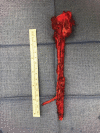Vascularized Fibular Epiphyseal Transfer for Pediatric Limb Salvage: Review of Applications and Outcomes
- PMID: 37859637
- PMCID: PMC10584290
- DOI: 10.1097/GOX.0000000000005354
Vascularized Fibular Epiphyseal Transfer for Pediatric Limb Salvage: Review of Applications and Outcomes
Abstract
Vascularized fibular epiphyseal transfer (VFET) offers a functional advantage in pediatric limb salvage due to the preservation of growth potential and an articular surface for remodeling. This review summarizes the available evidence on the clinical characteristics and outcomes of pediatric reconstruction applying VFET at different recipient sites and with varying techniques. VFET was used to reconstruct the proximal humerus, distal radius or ulna, proximal femur, distal fibula, calcaneus, and mandible. Although most often harvested on the anterior tibial artery, VFET has also been performed using the peroneal artery, the inferior lateral genicular artery, and a dual pedicle. Recipient site flap inset most often involved fixation with plates and/or screws as well as soft tissue reconstruction using a retained slip of biceps femoris tendon. Outcomes included limb growth, range of motion, and strength. The most common reported complications were bone flap fracture and peroneal nerve palsy. The anterior tibial artery was the most applied pedicle with reliable limb growth, but with the added risk of postoperative peroneal palsy. Bone flap fracture most often occurred at the proximal humerus and femur recipient sites. Plate fixation and the combined use of allograft had lower instances of bone flap fracture. This review highlights how the anticipated dynamic growth and remodeling this free flap offers in the long term must be weighed against its complexity and potential complications.
Copyright © 2023 The Authors. Published by Wolters Kluwer Health, Inc. on behalf of The American Society of Plastic Surgeons.
Conflict of interest statement
The authors have no financial interest to declare in relation to the content of this article.
Figures





Similar articles
-
Clinical and radiological results of vascularized fibular epiphyseal transfer after bone tumor resection in children.Orthop Traumatol Surg Res. 2020 Nov;106(7):1319-1324. doi: 10.1016/j.otsr.2020.03.037. Epub 2020 Oct 10. Orthop Traumatol Surg Res. 2020. PMID: 33051168
-
Long Term Results of Epiphyseal Transplant in Distal Radius Reconstruction in Children.Handchir Mikrochir Plast Chir. 2015 Apr;47(2):83-9. doi: 10.1055/s-0035-1547304. Epub 2015 Apr 21. Handchir Mikrochir Plast Chir. 2015. PMID: 25897577 Review.
-
Outcomes following Free Fibula Physeal Transfer for Pediatric Proximal Humerus Reconstruction: An International Multi-Institutional Study.Plast Reconstr Surg. 2023 Apr 1;151(4):805-813. doi: 10.1097/PRS.0000000000010001. Epub 2022 Dec 6. Plast Reconstr Surg. 2023. PMID: 36729876
-
Bipedicled vascularized fibula flap for proximal humerus defect in a child.Plast Reconstr Surg. 2001 Jan;107(1):155-7. doi: 10.1097/00006534-200101000-00024. Plast Reconstr Surg. 2001. PMID: 11176616
-
One-stage reconstruction of composite bone and soft-tissue defects in traumatic lower extremities.Plast Reconstr Surg. 2004 Nov;114(6):1457-66. doi: 10.1097/01.prs.0000138811.88807.65. Plast Reconstr Surg. 2004. PMID: 15509933 Review.
Cited by
-
Revolutionizing bone tumor management: cutting-edge breakthroughs in limb-saving treatments.Eur J Orthop Surg Traumatol. 2024 May;34(4):1741-1748. doi: 10.1007/s00590-024-03876-z. Epub 2024 Mar 10. Eur J Orthop Surg Traumatol. 2024. PMID: 38461457 Review.
-
Long-term Outcomes of Biological Reconstruction for Primary Bone Sarcoma of the Humerus.Cancer Diagn Progn. 2025 Mar 3;5(2):153-161. doi: 10.21873/cdp.10425. eCollection 2025 Mar-Apr. Cancer Diagn Progn. 2025. PMID: 40034949 Free PMC article.
References
-
- Tsuda Y, Tsoi K, Stevenson JD, et al. . Extendable endoprostheses in skeletally immature patients: a study of 124 children surviving more than 10 years after resection of bone sarcomas. J Bone Joint Surg Am. 2020;102:151–162. - PubMed
LinkOut - more resources
Full Text Sources
